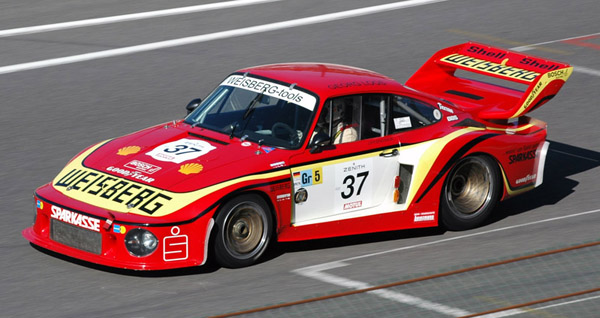1974 Porsche 911 Carrera RSR Turbo
The first turbocharged race version of the 911, racing in the prototype class, mainly to gain experience with a turbocharged 911 for the upcoming Groups 4 and 5 (expected to start in 1975, but delayed until 1976). Engine capacity reduced to 2.14 liter, to stay below the 3 liter prototype limit with the 1.4 turbo multiplication factor. One KKK turbocharger, with air-air intercooler in a body extension under the wing. Because it was raced in the prototype class, Porsche could perform almost unlimited modifications to the car. Nearly all exterior panels were replaced with fiberglass parts. The rear window was raised to improve air flow to the rear wing. An aluminium frame replaced part of the rear chassis. Aluminium roll cage. Rear wheels sprung by coil springs instead of torsion bars. The fuel tank was moved from the nose to the rear right seat area, boxed in with sheet metal; possibly this only applies to the later version, like the #22 at Le Mans. The early version had normal side-rear windows, like the #21 at Le Mans. A later version had closed side-rear windows with NACA ducts, the air being dumped in the engine bay.
|
| Overall length
| 4600 mm
| Front track
| 1467 mm
| Front wheels
| 10.5 x 15"
|
| Overall width
| 2020 mm
| Rear track
| 1620 mm
| Rear wheels
| 17 x 15"
|
| Height
| 1270 mm
| Wheel base
| 2271 mm
| Weight w/o fuel
| 825 kg
|
|
| 1/8
| Eidai-Grip
| BS2 ? 9800 ?
| 
| Opening doors, engine cover and luggage compartment. Detailed engine. Decals for #5 car, possibly #8 and #9 too like in the Entex reboxing. Reportedly this kit is difficult to build. Reported problems are incorrect instructions, bad fit of parts, chassis and body don't fit together, front suspension system mounts about 5 inches too far forward, ride height much too high (making it look like rally car) and lastly, the old decals will break up when dipped in water (coat first with Micro Liquid Decal Film). The Eidai company was renamed Grip around 1974. Jacques Joliff detailed this model to a very high level and shows a photo report on Best Balsa Kits.
|
|
| Entex
| 9040
| 
| Reboxing the Eidai-Grip kit. Of course it's not a '935' as listed on the box. Decals for #5, #8 and #9 cars. Instruction manual says 'Made in Japan'. See here for a built-up model. Jeff Palmer is building one and has an extensive photo report on Fotki. |
|
| Eidai-Grip
|
| 
| RC version of the above kit. Plastic body with opening doors, hood and bonnet, metal chassis. Sponge rubber tires, exhaust sound generator. Johnny_0 shows the box contents on his blog: Eidai (edaigrip) 1/8 Porsche turbo 2.1 RC car. |
|
|
| 1301
| 
| Another RC version. Plastic body with opening doors, hood and bonnet, metal chassis. It comes with two sets of decals: one with sheet #5 and #8 with Martini striping (probably identical to the above kit) and one sheet for a fantasy #12 with yellow-red striping, as portrayed on the box. A YouTube video by Joe Stagg shows the contents of the box: Oldest 1:8 scale RC car I've ever seen Porsche carrera martini racing remote controll eidai grip.
|
| 1/12
| Classic Models Museum
|
| 
| Resin model, with around 30 pieces. Single-piece body with separate engine cover. Engine is cast integrally with the chassis. Tires and wheels are cast integrally. Decals for #22 car, Van Lennep / Muller. Only the dark blue / light blue parts of the Martini striping are provided, the red parts must be painted. Some spelling errors, like 'Turbolador' and 'C V Lennep'. Small photo-etch fret with seat belt parts. See here for Christian 'Capri-Schorsch's attempt to build it.
|
|
| Mezzo Mix Models
|
| 
| Resin transkit using the Tamiya Porsche 934/935, available in two versions. The first versions contains body, rear wing, air scoop and wheels plus tires. The second version also includes a simple chassis, dashboard, seat, steering wheel, some interior parts, and an engine half. Decals will be avaible from two different dealers. The story behind this model can be found on the Automotive Forums.
|
|
| Model Factory Hiro
| K713
| 
| Issued in summer 2019. Decals for #22, Gijs van Lennep and Herbert Müller, Le Mans 1974. Full detail kit with plastic and white-metal parts, with complete engine, turned wheels and half-transparant injection molded parts to simulate glass-fiber parts. Here is a construction report by 'VR2' on the F1M forum.
|
|
|
| K-714
| 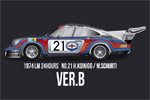
| Issued in summer 2019. Decals for #21, Helmuth Koinigg and Manfred Schurti, Le Mans 1974. This kit has a different engine fan and side rear windows. Work in progress report Porsche Carrera RSR Turbo 2.1 - Model Factory Hiro 1:12th - Ver B on the Britmodeller forum.
|
| 1/20
| Nitto
| 582
| 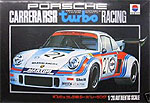
| Silver plastic body, black chassis parts. Opening doors. Individual window pieces that fit realistically flush with the trim. Normal glass side-rear windows. Motorized, but the interior does not appear to compromised by the batteries and motor. The large fuel tank in the cabin is absent though. No engine detail. Working suspension. There is a shape problem with the rear body: the add-onn extra rear window that continues into the wing suppprt is molded as an integral seamless part of the body, with the 'rain drip seam' fold in in the body absent, and this creates a hump-back appearance (see the 1/24 version below for a link showing the problems). The four NACA ducts in the rear wing support are all far too shallow. Front wheels are placed too deep inside the fenders (easily corrected). Funny mistake: on the rear wheel flares a Wiederhold (paint manufacturer) sponsor sticker was misinterpreted as small door (gas or oil filler) and engraved. Decals are not correct: the 21 car at Le Mans was driven by Schurti and Koinnig, not Muller and Van Lennep.
|
|
| Bandai
|
| 
| Reported, but unlikely to have existed. Bandai did issue a 1/20 scale Porsche 911 Turbo, but this was a street version, although with some race decals in one version. It was a green car with yellow sides, Bosch, Esso, Unichrom, BP and Grundig sponsor decals.
|
|
| Union
| MC56
| 
| Reissue of the Nitto model, without motorization however. Reportedly also a reissue of the Bandai/Entex kit, possibly all four models are the same? Part of 'The Memorial Collections' series. Decals are identical to the Nitto decals. See here for a built-up model
|
|
| ARII
| 1000-57-A
| 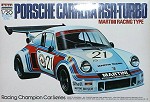
| This model is not a reissue of the Nitto model. The model represents the later version with closed side-rear windows with NACA ducts. The large fuel tank occupying the rear seat area and part of the passenger area is included, but the tank's shape looks rather incorrect. Separate doors. It has some shape problems: the bodywork ahead of the bonnet is horizontal instead of sloping, the headlight shape is rather bulky and square, all bonnet details (closing pins, oil filler cover, Porsche badge) are represented by raised details. Decals are for #21, but at Le Mans this car was of the early configuration with normal side-rear windows. Provisons for motorization, but FA-130 motor not included. 'Racing Champion Car Series'.
|
|
| Yodel
| YN2002
| 
| Another reissue of the Nitto model, body and decals are exactly identical. Not sure about motorization. 'Famous Car Collection' series
|
| 1/24
| Nitto
| 565
| 
| This model looks like a scaled down version of the Nitto 1/20 model, but there are differences. Like the 1/20 model, the four NACA ducts in the rear wing support are all far too shallow, there is no 'rain drip seam' on the rear body giving it the same hump-back appearance, and the Wiederhold sponsor sticker on the rear wheel flares was misinterpreted as small door (gas or oil filler) and engraved. Some of the differences are the wheels (standard Fuchs) and the doors that do not open. Body is the earlier version. Prepared for motorisation, but electric motor, battery and bulbs are not included. Shallow interior to allow for batteries. Minimal underside detail. Decals are for car #21. Japanese modeler Haltica built it and added a Fujimi 911 engine and scratch-built details under the front hood. For reference: Lovegt40 corrected the shape problems at the rear of the Esci reissue of this model.
|
|
|
| possibly 14047
| 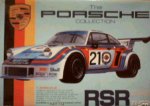
| Likely a later issue.
|
|
| Scale Craft - Nitto
|
| 
| Scale Craft issue, with simply a Scale Craft sticker added to the Nitto box.
|
|
| Entex
| 9577
| 
| Reboxed Nitto model: parts are identical but all white, box art is based on the Nitto original. First body style. Provisions for motorization, but no motor included. Decals are for car #21.
|
|
| Esci
| 3061
| 
| Former Nitto mold, Esci bought several Nitto molds after the company went under in 1985. Issued 1987. Only 42 parts. Chassis and interior modified slightly to remove battery and electric motor slots and attachments ('on/off' lettering remains on the bottom though). Interior is now a somewhat basic but full depth representation - but it lacks the large fuel tank that occupied the rear seat area. No roll cage. Decals are for car #9, which did not have turn lights in the front spoiler (Le Mans only probably on #21 and #22). Paolo 'LoveGT40' is restoring one, shown on Automotive Forums.
|
|
| Esci-Ertl
| 3077
| 
| 1992 reissue of above
|
|
| Tokyo Marui (aka 'Tilt')
| MT-51-W01
| 
| Later body style. Described as completely different than the Nitto/Esci one. It has a different body with covered rear quarter windows, better duct openings and a better interior. Motorized. Minimal underside detail and bad wheels and tires. No 'rain drip seam' on the rear body (see Nitto 1/20). Decals are for car #22. Japanese modeler Haltica built it.
|
|
|
|
| 
| Minor box art variation.
|
|
| Otaki
| OT3-80
| 
| Listed as a 'Porsche Turbo Racing'. The box art picture does not resemble the kit inside, which is a Carrera RSR Turbo! It has covered up rear side windows, like the Tokyo Marui model. The wheels are undersize and chromed. The decals resemble that of the Carrera RSR that won the 1973 Targa Florio. Molded in red with Martini markings, #8, which probably never existed for real. Electric motor included. See here for a built-up model.
|
|
| Model Factory Hiro
| MFH24PRSR or X004
| 
| Resin curbside model, no engine or tank details, rather simple for its very high price (165$). Turned wheels (reportedly wrong in shape), rubber tyres, photo-etched, resin and white metal parts. 1974 Le Mans decals for #22, but with erronous 1973 LM group / class stickers. The front bumper appears to have a shape problem: it extends too far forward from the hood. The front hood lacks an oil filler. The interior has big mistakes. The real car had a large black sheet metal fuel cell inside the cockpit, filling the area behind and to the right of the driver. The model lacks this completely. The dashboard is reportedly completely wrong, and the rollcage should be a six-point version. See here for Riccardo Zanelli's model.
|
|
| Fujimi
| CW-14
| 
| Issued in July 2017 as a car from 'Circuit Wolf', a racing manga published in Japan. The model depicts the later version with closed side-rear windows with NACA ducts. Apparently the original car in the Porsche Museum was scanned to obtain the correct body shape. Separate engine cover and hood, but no detailing underneath. The engine is molded in half-relief. Chassis and suspension look well detailed. The engine cover / rear wing support is made with a slide mold, to reproduce the various inlets in that part. Bruce Scully built his model with a fantasy Martini livery.
|
|
|
| RS-23
| 
| Issued in November 2017, same as above but with decals for Martini #22, Le Mans, Van Lennep / Müller. Johan Brusefält reports that the wheel diameters are slightly oversize (probably to make the model look better), 18.4 instead of 17.7 mm, and the spokes of the rear wheels could be better. The real wheels were most likely similar or identical to those on the Porsche 917. The 917 used 9", 10.5", 12", 15" and 17" wheels, all 15" diameter, so the 10.5x15" and 17x15" were available for use on the Carrera RSR Turbo. He made sells replacement 3D-printed wheels at Shapeways. The tires are also strange: diameters are 27.5 mm (front) and 25.5 mm (rear) which looks strange: huge at the front and small at the rear. Actual tire sizes are near-impossible to find however. Johan Brusefalt sells replacement 3D-printed tires at Shapeways of 26.0-26.5 mm diameter (edges/center).
|
|
|
| RS-99
| 
| Issued in 2018, with decals for the 1974 Watkins Glen race, #9, Van Lennep / Müller.
|
|
| Italeri
| 3625
| 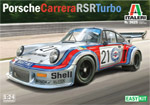
| Reissue of the old Esci (former Nitto) kit. Planned for 2021, but issued in 2023. Decals for #21 and #22 during Le Mans 1974, but the body style is not correct for #22. Review by IPMS-USA.
|
| 1/28
| Nitto
| 575
| 
| Listed in the 1979 English-language catalog. Second body style. Motorized. Catalog photo shows decals are for car #22. Length listed in catalog as 185 mm. If the overall length figure of 4600 mm is correct, this would make the scale 1/25!
|
|
|
| 4 ?
560?
| 
| Listed on the box as 1/26 scale, but it is identical to the Nitto 1/28 model. Very likely a 'Circuit Wolf' issue, with decals for #3 as in the manga comic. The awkward scale is listed on the box. Motorized. Another model from the series (with similar box art and listed scale) is a Ferrari Dino with #17 decals, and '1' printed on the box as the series number. This numbering coincides with the 1979 catalog listing for the 1/28 car series, which makes the scale questionable.
|
|
| Entex
| 9038
| 
| Reissue of the Nitto model. Scale listed as 1/25 on the box, but most likely it is 1/28 scale. Note also the similar box art of the Nitto 575 kit. Second body style. Probably not motorized. Decals are for car #22, whereas box art shows #21.
|
1976 Porsche 934 and 934/5
|
|
Version developed for Group 4 racing. 3.0 liter turbo engine, with a complex intercooler system: each cilinder bank had its own water-air intercooler, and two radiators were mounted in the nose, since no radiator openings were allowed in the rear fenders. The rules imposed a minimum weight of 1120 kg, and subsequently series bodywork was used, and little was removed from the interior (rear seat, sound proofing material) and for example the electric window openers were retained. Aluminium roll cage and stiffening bars in the tank area. 14 inch wide tires allowed by rules, hence 12.5" wide wheels for the rear. To increase tire surface, 16" diameter wheels were used, which Porsche didn't have, hence the choice for BBS modular wheels. Rear suspension torsion bar springs supported by coil springs. Approximately 30 built for customers, there was no works race team.
In 1977 ten more 934s were built. The European Group 4 lost much of its appeal in 1977, and therefore nine out of ten went to the USA, for use in Trans-Am and IMSA. They were called '934/5' since they included some 935 components. Modifications included with wider wheels (16" rear, front unclear), a bigger turbo for more power, and a 935-76 style rear wing. For IMSA use the 935 wing had to be swapped for an RSR-type wing. Previously, the Gunze '934/5' model was thought to represent this version, but that model was actually a Kremer K1. Reji Model makes a 'Porsche 934/5 rear spoiler' (SP969).
|
| Overall length
| 4200 mm (Frere p162)
4291 mm (Barth/Dobronz p24)
| Front track
| 1502 mm (Frere p162)
1481 mm (Barth/Dobronz p24)
1481 mm (Barth/Dobronz p246, 10.5" wheel)
| Front wheels
| 10.5 x 16" (Frere p162)
10.5 x 16" (Barth/Dobronz p24)
10.5 x 16" (Barth/Dobronz p253 *)
|
| Overall width
| 1870 mm (Frere p162)
1986 mm (Barth/Dobronz p24)
1875 mm (Barth/Dobronz p246)
| Rear track
| 1535 mm (Frere p162)
1565 mm (Barth/Dobronz p24)
1506 mm (Barth/Dobronz p246 with 12.5" wheel)
| Rear wheels
| 12.5 x 16" (Frere p162)
15.0 x 16" (Barth/Dobronz p24)
12.5 x 16" (Barth/Dobronz p253 *)
|
| Height
| 1270 mm (Frere p162)
~1300 mm (Barth/Dobronz p24)
~1300 mm (Barth/Dobronz p246)
| Wheel base
| 2271 mm (Frere p162)
2268 mm (Barth/Dobronz p24)
2268 mm (Barth/Dobronz p246)
| Weight w/o fuel
| 1120 kg (Frere p162)
1120 kg (Barth/Dobronz p24)
1120 kg (Barth/Dobronz p246)
|
* values from homologation document. It list the following tires as reference for height measurements: Dunlop 275/600 x 16 Regen / Dunlop 325/625 x 16 Regen. Page 24 lists Goodyear 12.5/23.5 x 16 and 14.0/25.5 x 16, or 318/597 x 16 and 356/648 x 16 in millimeters.
|
|
| 1/12
| Tamiya
| 12020
| 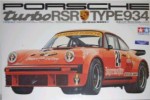
| Excellent model. Issued in 1977. Decals for Jagermeister #24 and #25. It appears that there is a problem with the width of the model, which is most visible in the roof, which looks too wide and too flat. Long time ago I read a report of someone visiting the Tamiya factory, where among others he saw the master model of the then new 934. Tamiya had bought a real 930 to base the model on, and I think it's safe to assume they modeled it correctly. The next day he came back and saw a dark or light line down the middle of the model. He looked better and asked for information. Turns out they had decided to give the model an optical correction, since it looked too narrow from a typical modeler's perspective (i.e. from above). They had cut it in half, in left and right halves, added a spacer and put it back together. This master was then used to cut molds. Since 1 millimeter would have hardly made a difference, I would guess it was 2 to 3 millimeters. 'Stu_davros' built it with Wrangler decals.
|
|
|
| 12040
| 
| Reissue from late 2008, with photo-etched detail parts
|
|
|
| 12055
| 
| Reissue from December 2019, with photo-etched detail parts. Slick instead of profile tires. No logos embossed on the rubber, and no decals supplied either.
|
|
|
| 12056
| 
| Issued October 2020. Vaillant #5 version, as raced in the 1976 DRM season. Photo-etched parts. Slick tires, no logos embossed on the rubber, but with Goodyear decals.
|
|
|
| RA1201
| 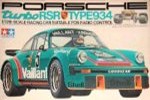
| RC model with model-like plastic body. Vaillant markings. Three separate decal sheets available: SP-1002 (Tebernum, Georg Loos), SP-1003 (Jägermeister #24 or 25, Max Moritz) and SP-1004 (Vaillant #5 or 9, Kremer)
|
|
|
| 57101
| 
| RC model with vacform plastic body, with dozens of injection moulded parts. Vaillant markings. Reissue of 58001 from 1976
|
| 1/20
| Eidai-Grip
|
| 
| Listed as 'Porsche 934 Turbo Martini', which is strange, since no 934s were raced with Martini sponsoring as far as I know. Likely one of their 930 road cars boxed as a race car. No further information.
|
| 1/24
| Esci
| 3001
| 
| Nicely shaped body. It is possibly a bit too wide at 84.5 mm = 2028 mm. The length of 178.3 = 4279 mm agrees with one of the numbers listed above. Engine, gearbox and rear suspension as half-relief in the bottom piece. Well-detailed interior with full roll cage. Separate brake discs and calipers. Mesh is supplied for the open inlets in the front spoiler. The wheels are approximately one inch too small: 15 instead of 16 inch. According to the Barth/Dobronz book (page 24), Goodyear tire sizes were 12.5/23.5x16 and 14.0/25.5x16 respectively (Barth/Dobronz p24). This translates to 13.2 by 24.8 mm and 14.8 by 27.0 mm in 1/24 scale. Dunlop tire sizes were 275/600x16 and 325/625x16 respectively (Barth/Dobronz p253). This translates to 11.5 by 25.0 mm and 13.5 by 26.0 mm. The kit tires are 12.0 by 24.7 mm and 14.4 by 25.5 mm. Decals for Georg Loos car driven by Toine Hezemans and Tim Schenken at the Six Hours of Monza, 1976. Former Esci modeller and master developer 'lovegt40' compares the old Esci model to the new Tamiya model on Automotive Forums.
|
|
|
| 3001
| 
| Alternative boxing, possibly US only, probably newer than the above.
|
|
|
| 3004
| 
| Same plastic as 3001. Decals for #12 Jagermeister driven by Bob Wollek at Mainz-Finthen in June 1977, and #9 Vaillant driven by Helmut Kelleners at Nurburgring May 1976.
|
|
| Revell-Esci
| H-2270
| 
| Box art largely identical to the Esci box art shown above and the Esci-Scalecraft box art shown below, but with a larger car.
|
|
|
| H-2272
| 
| Issued under the Revell-Esci label with slightly different box.
|
|
| Esci-Scale Craft
| 3001 ?
| 
| Likely US only.
|
|
|
| 3001
| 
| Likely US only.
|
|
|
| ?
| 
| Likely US only.
|
|
| Esci-Humbrol
| 3001 ?
| 
| Humbrol logo added to the box art that was also used for the Esci-Scale Craft version
|
|
|
| 3004
| 
| The box art photo is deformed a bit because of the photography
|
|
| Ertl-Esci
| 8260
| 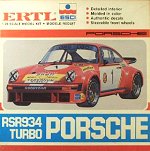
| Likely US only. Georg Loos livery. Packaged in a square box.
|
|
| Heller
| 80714
| 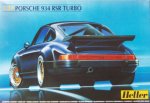
| A reissue of the Esci kit. The open inlets with separate mesh in the nose spoiler were filled in. The box art shows a street car, but the kit is the full racer, without decals however. A good base for aftermarket 934 decals. Build report by 'dekon' on Automotive forums of a white Vasek Polak car.
|
|
|
| 80714
| 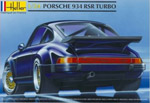
| 2014 reissue of the above kit, with slightly changed box art with the old Heller logo
|
|
| Aardvark Models
| AM-8
| 
| Conversion kit (transkit) that uses a Fujimi 911 as donor - announced late 2009
|
|
| Tamiya
| 24328
| 
| Issued in 2013. Orange and light grey sprues. No opening doors or hoods, half-relief engine. Contains small photo-etch set. Decals for Jagermeister #24 and #25 cars, but lacks Shell and Dunlop decals that go between the door and rear wheel opening. Dry transfers for Dunlop tire lettering is not included either. The body in orange plastic could be difficult to cover in case you want to do another color scheme. The problems reported so far is that the cooling slots at the top of the rear window are supplied as a decal, the rear wheels are too deep (the disc is 6.7 mm from the rim edge, judgng from photos it should be around 3.5 mm), the photoetched front grilles are a bit coarse, the emergency switch on top of the dashboard is missing, and the dial decals are incorrect. Build report by David Durst on Scalehaze. IPMS Germany has a review in German. For a complete demonstration of the model, kamu-tomi posted a 48-part set of YouTube videos that document his build (all silent). ToyGear has a partial build in Russian, and I think they conclude that the tires are too big. Indycals reports that the tires are far too narrow (see the different wheel sizes listed in the car description for a possible explanation), and they offer replacement tires with Goodyear and Dunlop markings. Pierre Rivard shows his model on the MCM forum.
|
|
|
| 24334
| 
| Issued in 2014. Decals for Vaillant #5 car. reportedly the striping has a color problem: the magenta part should be purple. Dry transfers for 'Goodyear' on the tire sidewalls. Black Shell script logos that go below the bumper, next to the front wheels, are missing from the decal sheet. Build report by 'Cooper645' on BritModeller.
|
|
| Revell-Germany
| 07031
| 
| Issued in April 2017. Decals for Jagermeister #53 car. First comments are that is a new tool with no relation to any of the other 934 models. The engine is complete, not half-relief molded as with many other kits. The front hood opens and tank details are present. There are some extra parts in the box that indicate possible other versions in the future. The discs of the rear wheel are set too deep, compared to all photos they I checked so far. The box art shows the correct depth. IPMS Germany has a review in German. Build report by Peter Warmerdam in Dutch on Modelbrouwers. Indycals reports that the tires are far too narrow (see the different wheel sizes listed in the car description for a possible explanation), and they offer replacement tires with Goodyear and Dunlop markings.
|
|
|
| 07032
| 
| Issued in April 2017. Decals for Vaillant #9 car. IPMS Germany has a review in German. Build report by Bruce Scully on the MCM forum.
|
|
|
| 07685
| 
| Released early 2019. Decals for Martini #50 car.
|
1976 Porsche 935-76 (works)
|
|
Version developed for Group 5 racing, with much more freedom than Group 4. 2.86 liter turbo engine to stay in the under 4 liter class (1.4 turbo multiplication factor) with 970 kg minimum weight. 590 hp output. Basic chassis of the series 930 retained, but doors, engine and boot covers, fenders and front spoiler were made of glassfiber/foam. Bare interior. Side and rear windows of Plexiglass. Aluminium roll cage and fuel tank bracing. Rear wing was based on the original 930 wing, with side plates and horizontal wing element added. Car was 90 kg under the weight limit, so lead balast was placed in the nose and passenger foot well area. 114 liter tank in the nose. Front and rear torsion springs deleted in favor of coil springs. Maximum tire width 16", hence 15" wheels at the rear. Brake system as used in 917. Two cars were built.
Four body styles can be distinguished. The car's first race was at Mugello, where it had the flat front fenders with headlights in the front spoiler. Among others, this nose shape was disputed by the organisers, but became standard later on. The flat nose was combined with with rounded rear fenders like the RSR Turbo. This will be called the first body style in the kit list below. Due to the disputes, the nose was replaced by 911-style front fenders/headlights in the second and third races (Vallelunga and Silverstone) and possibly during the Le Mans test, at least on car #40. This will be called the second body style. The third body style (remaining races) had square headlight covers and square rear fenders that extended to the rear of the car. The larger rear fenders were required to make room for intercooler radiators, after CSI banned the air-air intercooler that didn't fit under the original bonnet. It seems that the 934 radiator lay-out was used as an interim solution for one race. The fourth body style is a combination between the second and third: square rear fenders combined with the round headlights of the second body style (still looking where this combination was used).
|
| Overall length
| 4655 mm (Frere p162)
4655 mm (Barth/Dobronz p258)
| Front track
| 1502 mm (Frere p162)
1500 mm (Barth/Dobronz p258)
| Front wheels
| 11 x 16" with 275/600-16 tires (Frere p162)
11 x 16" with Dunlop 275/600-16 tires (Barth/Dobronz p263)
|
| Overall width
| 1998 mm (Frere p162)
1999 mm (Barth/Dobronz p258)
| Rear track
| 1560 mm (Frere p162)
1560 mm (Barth/Dobronz p258)
| Rear wheels
| 15 x 19" with 350/700-19 tires (Frere p162)
14.5 x 19" with Dunlop 350/700-19 tires (Barth/Dobronz p263)
|
| Height
| 1270 mm (Frere p162)
~1270 mm (Barth/Dobronz p258)
| Wheel base
| 2271 mm (Frere p162)
2265 mm (Barth/Dobronz p258)
| Weight w/o fuel
| 970 kg (Frere p162)
970 kg (Barth/Dobronz p258)
|
|
| 1/12
| Tamiya
| 12023
| 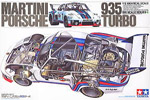
| Third body style. Excellent model. Released in 1977. It probably has the same width problem as described in the Tamiya 934 entry. 'robrex' did a long but incomplete build thread with lots of detailing.
|
|
|
| 12038
| 
| 2008 reissue with a sheet of photo-etched parts. Ron Clark posted almost 400 photos of his building process. Eric C built his model with minimal aftermarket items.
|
|
|
| 12057
| 
| 2020 reissue with a sheet of photo-etched parts.
|
|
|
| RA1202
| 
| RC model with hard plastic body, possibly largely identical to that of the above model. Tinted windows. Third body style.
|
|
|
| SP1048
| 
| Spare parts set for the RC model. Complete hard plastic body, tinted glas, decal sheets for Martini #1 and #3, and Jagermeister #52.
|
|
| Monkey Claw Models
|
| 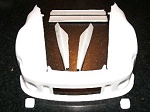
| Nine piece resin set to convert Tamiya's 935-76 in a 1977, 1978 or 1979 customer car. Set includes in the nose section (in three pieces instead of one like in the photo: front apron and fenders with fiberglass pattern underside), lamp buckets, running boards / rockers, and two piece rear wing.
|
|
|
|
| 
| Twin-turbo set to convert the Tamiya 935 engine into a 1978 customer version. It has the intercoolers extending forward from the engine, and will also require a displaced rear cabin bulkhead to make room for it. Masters are ready, but not issued yet
|
| 1/20
| Tamiya
| GC2005 or 2005
| 
| Third body style. Issued in 1977. Engine/rear axle assembly can be exchanged for a battery/motor unit. Decals for Martini #1 and Jägermeister, but the latter had circular headlight covers with single headlights. It possibly has the same width problem as described in the Tamiya 1/12 934 entry. You can see the finished model by 935k3 on the MCM forum, plus the build report. On BritModeller 'Big Phil' built his model as the Le Mans #40 car.
|
|
|
| 20005
| 
| Reissue from 1999.
|
|
|
| 20070
| 
| Reissued in 2023. Motorization option deleted. Cartograf decals for Martini #1 and #3. New tires. Review on Fine Scale Modeler website.
|
|
| Fujimi
| RC7
| 
| Third body style, with Le Mans details such as number lights. Opening doors, engine cover and front cover. Motorization combined with a 30 part engine/rear axle assembly. Either batteries or fuel tank under openable front cover. World Car Series No. 7. Decals for #40.
|
|
|
|
| 
| 'Black Porsche' issue of the above kit. Decals for Martini #1. No 1:1 original exists.
|
|
|
|
| 
| Japanese boxing of the above kit. The plastic of the body appears to contain metal flakes.
|
|
| Dexim
| D-3007
| 
| Judging from the box art, a German reboxing of the Fujimi model.
|
| 1/24
| Nichimo
| MW2402
| 
| First body style. Motorized, with batteries in cockpit area, the interior is therefore heavily compromised. No glazing for the headlights. Decals for #1, 4 and 40. See here for a built-up model
|
|
|
| MW2412
| 
| 'Black Porsche' issue, like the Fujimi black Porsches
|
|
|
|
| 
| Reissue in the 'World Wide Worthy Car-Collection' series
|
|
|
| WW2402
| 
| Reissue in the 'World Wide Worthy Car-Collection' series
|
|
|
| WW2402
| 
| Probably a more recent issue, and also part of the 'World Wide Worthy Car-Collection'. Decals for #0, #1 and #4, plus Le Mans stickers
|
|
| Tamiya
| 24001
| 
| First body style. Motorized, but since batteries are fore and aft of the motor, less compromised interior than Nichimo. The area behind the driver is however still completely incorrect. Slightly nicer molding than Nichimo. It possibly has the same width problem as described in the Tamiya 1/12 934 entry. See here for a built-up model by a Japanese modeler (can't find his name). 'Icon Modeler' also built this model. 'lovegt40' converted the model from the first to the third body style (end result photos). 'E46nm52' is building his model straight from the box.
|
|
|
|
| 
| Box art variation with Porsche logo between 'Porsche' and '935'.
|
|
|
| 24311
| 
| 2010 reissue with Cartograf decals, with (among others) revised Martini striping and instrument panel decals. Revised instruction sheet, with different order and all motorization details left out.
|
|
| Scale Designs
| SDF3
| 
| Curbside kit. 1976 Le Mans version (square tail) with early air aftercooler (later banned). Decals for 1976 Le Mans car #20.
|
|
|
| SDF7
| 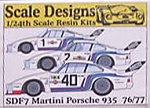
| Complete kit with full engine detail with two photoetch sheets. 1976 Le Mans version (square tail) with early air aftercooler (later banned) and single turbo motor. Decals for the 4th place Le Mans 1976 car #40, 1976 championship cars also included. Almost the same car as the Tamiya 1/12th scale 935.
|
|
| Aardvark Models
| AM-4
| 
| Resin conversion kit for the Tamiya #24001 kit, to create the second body style, with 911-style front fenders/headlights as used in the Vallelunga and Silverstone races. The conversion kit consists of a body shell, separate engine cover with wing and two headlight buckets, no decals. More details on the Aardvark website. 'Icon Modeler' used this transkit to build #1 as raced at Vallelunga in 1976 (scroll down a bit past the #4 Mugello car).
|
|
| Studio 27
| TK2466
| 
| Extensive conversion set (transkit) for the 1976 Vallelunga car. Complete resin body, metal wheels and rubber tyres, a few metal engine parts, two photo-etch sheets, two decal sheets. Build report by 'Micha' on Automotive Forums
|
|
|
| TK2476
| 
| Same as TK2466, unclear why Studio 27 renumbered several kits.
|
|
|
| TK2473
| 
| Extensive transkit, with a complete resin body, metal wheels and rubber tyres, a few metal engine parts, three photo-etch sheets, two decal sheets. Decals for white #40 with Martini markings, Le Mans 1976. Recommended base kit: Tamiya 934.
|
|
|
| TK2478
| 
| Same as TK2473, unclear why Studio 27 renumbered several kits.
|
|
| Beemax
| 24039
| 
| Announced for late 2022
|
| 1/32
| MPC
| 1-3236
| 
| Snap model, with engine detail and removable engine cover. I think represents the third body style. Copyrighted 1982.
|
|
| AMT-Ertl
| 8725
| 
| Snap model, most likely a reissue of the MPC model. Also sold as a set of three with a Diablo and a Firebird (#8747, 1993).
|
|
| Airfix
| 9-03413
| 
| Appears identical to the MPC model. Snap model.
|
|
| Matchbox
| PK308
| 
| Fourth body style. Decals for Martini #1, reportedly at Watkins Glen 1976, but here #2 and #4 were raced, not #1. 1978 catalog drawing is different from the box-art shown here and shows a 935-77!
|
|
|
| PK311
| 
| Decals for Liqui Moly #66. Fourth body style. Probably the same plastic as PK308.
|
|
|
| PK311
| 
| Later boxing style.
|
|
| Revell
| 99003
| 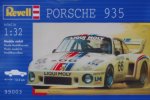
| Reissue of Matchbox kit. Decals for Liqui Moly #66.
|
|
|
| 07238
| 
| Reissue of Matchbox kit. Jägermeister #52.
|
|
| DiTech Produktion (DP)
| B 32-003
| 
| Resin body, unpainted.
|
|
|
| B 32-004
| 
| Resin body, painted with #52 Jägermeister decals.
|
|
|
| B 32-033
| 
| Resin body, unpainted.
|
|
|
| B 32-034
| 
| Resin body, painted with 1978 #30 Momo decals.
|
1/40
| Imai
| B609
| 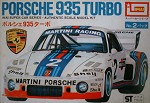
| First body style. Scale not confirmed
|
1976 Porsche 935-K1
|
|
In the 1976 season, no customer version of the 935 was available. The Kremer brothers got the specifications and some 935 parts from Porsche, and built their own car. The car was retrospectively called K1. Only one was built. It retained the headlights in the fenders, like the road-going 911 / 930, but had a 935-style front dam. A 935 wing was used. Initially it had rear fenders that resembled those of the RSR Turbo, but later they were changed to larger units with an ugly cut-off rear side. The car appears to have used 16" and 19" rear wheels. Technical data taken from 'Rallye Racing Motormagazin', January 1977 issue.
|
| Overall length
| 4680 mm
| Front track
| 1502 mm
| Front wheels
| 10.5 x 16" with 10.0/23.0x16 Goodyear tires
|
| Overall width
| 1970 mm
| Rear track
| 1558 mm
| Rear wheels
| 14.5 x 19" with 14.0/27.5x19 Goodyear tires
|
| Height
| 1265 mm
| Wheel base
| 2271 mm
| Weight w/o fuel
| 970 kg
|
|
|
|
|
| Gunze Sangyo
| G101
| 
| Box says '934/5', but instead it is a Kremer modified 935 K1, with second style of rear fenders. Motorized kit with limited interior detail (seat, dash, and partial roll hoop). Body molded in white. Decals for #2 Vaillant.
|
|
|
| G118
| 
| Reissue with #1 Camel GT markings. Body molded in brown. Reportedly the real car was bought by the IMSA organizers and marked up to promote the Camel GT series, but the Barth/Dobronz book does not list it in the car's history. A Camel advertisement shows a similarly painted K3 that could have been the inspiration too.
|
|
|
| G118
| 
| Variation on the above boxing, with newer blue-white Gunze Sangyo logo. Build report by 'fireguy' on the Road Race Model Cars Board.
|
|
|
| G132
| 
| 1984 boxing with the same decals as G101. Issues G143 (decals as G101) and G-146 (decals for unspecified #185) are also reported
|
|
| Testors
| 391
| 
| 'Kremer Porsche 934'. 1986 reboxing of the Gunze kit. JC Reckner shows his work with this model on the MCM forum.
|
|
| Airfix
| 06408-8
| 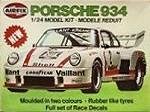
| A reboxing of the Gunze Sangyo G101 model. 1979 copyright date. Reportedly has a modified chassis, with electric switch removed and possibly front suspension integrated in chassis. Jeremy Banks did the box art illustration. Gunze did not supply the original box illustration, so it had to be recreated from a Gunze box. Some of the decals had their colours changed, possibly the decal sheet was revised.
|
|
| Studio 27
| TK2467
| 
| Extensive conversion set (transkit) for the Kremer K1, in the early style with RSR Turbo-style rear fenders and possibly 16" rear wheels. Complete resin body, metal wheels and rubber tyres, a few metal engine parts, two photo-etch sheets, one decal sheet. Decals for three 1976 races: #10 Silverstone, #3 Vallelunga, #5 Mugello.
|
|
|
| TK2477
| 
| Same as TK2467, unclear why Studio 27 renumbered several kits.
|
1977 Porsche 935-77 (works)
The Group 5 rules were changed for the 1977 season. To allow more room for turbos, coolers and exhaust systems, the floor could be raised to door sill level, the bulkhead between engine bay and cockpit could be moved 20 centimeters, and the car structure (that should be retained) was defined as the part between the front and rear bulkheads. This allowed Porsche to install a better water-air intercooler in an enlarged engine bay. The front suspension geometry was improved. Instead of a single large turbo, the engine received two smaller turbos, but supposedly it didn't gain power, just more flexibility and less turbo lag. Improved roll cage adding some stiffness.
The bodywork was restyled: a new nose section with slightly raised front fenders with rear view mirror fairings, more square rear fenders, air inlets behind rear side windows (likely feeding the turbos), narrower rear wing, wing supports integral with engine cover, running boards, and a second rear view window placed over the original window (the rules merely required that the original window to be retained), to improve airflow to the wing. The original 930 rear wing was no longer used, but could be fitted (as required) inside the new body with some persuasion. Three works cars were built.
|
| Overall length
| 4680 mm
| Front track
| 1502 mm
| Front wheels
| 11 x 16" with 275/600-16 tires
|
| Overall width
| 1998 mm
| Rear track
| 1560 mm
| Rear wheels
| 15 x 19" with 350/700-19 tires
|
| Height
| 1265 mm
| Wheel base
| 2271 mm
| Weight w/o fuel
| 970 kg
|
|
| 1/12
| Nikko
| 37317
| 
| RC model, body appears to be injected plastic. Windows are possibly tinted blue.
|
| 1/20
| Nakamura
| KNS-5306 147-1...
| 
| Opening doors. Steering front wheels. Decals for Martini #50. Motorized.
|
| 1/24
| Nitto
| 14048 and/or 634
| 
| Optional motorization with single AA / UM-3 battery, but electric motor not included. Detachable engine cover/rear wing, with engine but with limited detail. Rear fender longer and squarer compared to Bandai and Tokyo-Marui. No radiators in rear fenders, just openings. Front wheel/tires approximately right size, rear wheel one inch size too large (20 instead of 19), which creates a visual mismatch. Decals for #1, difficult to apply (stiff). Build report by JC Reckner on the Road Race Model Cars Board.
|
|
|
| 14048
| 
| Likely a later issue.
|
|
|
| 645
| 
| Reissue with 'aoshse Racing' markings which are probably fictitious. The cartoon character on the box may indicate a relation with a comic series.
|
|
| Tokyo-Marui (aka 'Tilt')
| MT-78-W16
| 
| Rear fender rounder and shorter compared to Nitto and Imai. Wheel/tire sizes OK. Opening doors. Interior with correct roll cage, seat and intercooler piping. Motorized and working lights. Decals are easy to apply, for #1.
|
|
| Bandai
| 8102
| 
| Rear fender rounder and shorter compared to Nitto and Imai. Wheel/tire sizes OK. Decals are easy to apply, for #1. See here for a built-up model.
|
|
|
|
| 
| Reportedly pink car as raced in the All-Japan GT Championship.
|
|
| Imai
| B-626
| 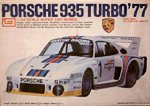
| Model is prepared for motorization, but comes without an electric motor. L x W x H is 197 x 89 x 54 mm according to box. 'Minimum interior details' mentioned on the box. Rear fender longer and squarer compared to Bandai and Tokyo-Marui. Spoiler appears to wide and bulky. Spoiler is of the type used at the Nürburgring, decals are for Mugello race. Front wheel/tires too large, rear wheel/tire size OK. No engine compartment vents behind the rear window. Decals are easy to apply, for Martini #1.
|
|
|
|
| 
| Box art variation
|
|
|
| B-637
| 
| A motorised track racing model, with a vacform clear body, running of 3 or 5 batteries. Decals for Martini #1
|
|
|
| B-637
| 
| Englishized version of the above box, with a sticker pasted over most of the Japanese text
|
|
|
| 530107
| 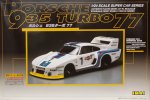
| Reissue. "Super Car Series #4".
|
|
| Aoshima
| SR-03
| 
| Probably the first issue of this kit, see the '16626' entry for details. This issue has clear windows, not tinted.
|
|
|
|
| 
| Slight variation of the box art
|
|
|
| 16626
| 
| Single-piece body. Interior with seat, fire extinguisher and roll cage. Motorised (FA130) with two batteries. Dark-tinted window inserts. Factory BBS wheels with Le Mans style cooling discs and Dunlop racing slicks. Posable front wheels. Decals for Martini #1. The rear wheel openings are very noticably too short vertically. Also reported: the rear fenders' trailing edge is too vertical. But, the front air dam has a really nice shape. It is not like any of the other models but would look good for certain privateer versions. Japanese modeler Haltica built it.
|
|
|
|
| 
| Fictional 'Porsche Racing' markings with Martini-like stripes. #1
|
|
|
|
| 
| 'Porsche 935-77 Turbo Fisco White Special'. Includes large steel wire 'bumpers' on the sides. Some black knob is mounted on the roof.
|
|
| Fujimi
| SM4
| 
| The body is very similar in appearance and size to the Nitto (then Esci then AMT then Italeri) kit, but it does not have a separate engine cover. There is some shape difference at the leading edge of the rear fenders, and the floor boards running under the doors have more 'Coke-bottle' shape. The kit only provides a very shallow interior because of the motorization that uses an RE-26 electric motor (not included). It uses three AA batteries. The model can be set up for working head and tail lights (probably no bulbs included though). For motorized racing, the model can be fitted with a spring-loaded front bumper. Decals for Martini #1.
|
|
| AMT-Ertl
| 8866
| 
| Reissue (around 1991) of the Nitto kit (detoured via Esci as the 935 Baby), slightly modified to remove the holes and brackets of the electric motor and gears. Includes Martini #1 decals. The contents are completely identical to the Esci-Ertl 935 Baby model (see below). The decals are the same graphics, but printed poorer. The finished model of 'NeedMYModelTime' is shown on Automotive Forums, and the model of 'cjhm' is shown on Britmodeller. Jacob Bonnell built his model straight from the box.
|
|
|
| 30072
| 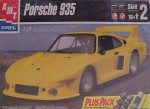
| 1998 reissue. 'Plus Pack' version including paint, brush and glue. Includes Martini race decals.
|
|
| Nichimo
| FC-2403
| 
| Scale model with roller guide parts for some kind of slot track use, with four batteries. 'Full Speed Compe Special'. Likely fake 'Autobacs' #1 markings (boxart) plus various decals such as KKK Turbolader, Bridgestone, Impul, Coca Cola and others
|
|
|
| FC-2404
| 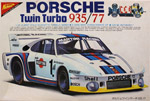
| Normal scale model assembly kit. Decals for Martini #1. Can be motorized. A built-up model gives me the impression that the wheel openings should be taller, and the wheels should be given a wider track (they are positioned too deep inside the wheel wells).
|
|
| Entex
| 9578
| 
| Reboxing of the Nitto model (see above). The parts are molded in black, white, clear, and chrome. Detachable engine cover, front and rear suspension, steerable front wheels, interior with racing bucket seat and roll bar, BBS racing alloy wheels with Dunlop rubber tires. Decals for Martini #1.
|
|
| Italeri
| 3696
| 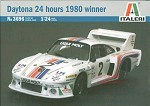
| Issued late 2007. It's a reissue of the former Esci 935 Baby model (see below) and AMT-Ertl 935-77 model (see above) with new decals for the #2 Liqui Molly 1980 Daytona 24 hours winner. The 1:1 car had 935-77 bodywork, but underneath it's not a 935-77, since it had a factory-built tube chassis for the Joest team. It's usually referred to as a 935J. If you're in the US, you can also buy the Speedline decals (sheet SPD16) for 10 dollars and a cheap AMT 935 instead of spending 30 euros on this model. JC Reckner shows his work with this model on the Race Car Models forum; Pierre Rivard shows his model on the MCM forum.
|
| 1/28
| Eidai/Grip
| GT32
| 
| A diecast model instead of a plastic model, shown for reference, since it's easy to confuse with a kit. Openable front and rear lids, plus doors.
Available in white and silver paint with Martini markings
|
|
| Nitto
| 641
| 
| Not a downscaled 1/24 model. Roof line slopes down much more, rear wing endplates appear much too small, wheels are much too small with respect to the tires. Decals for #1.
|
|
|
| 14064
| 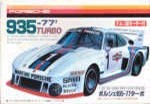
| Reissue. Decals for Martini #1.
|
|
| ARII
| AR-68A
| 
| Martini markings, #1. With electric motor, batteries in separate holder, connected via wires
|
|
|
| AR-68E
| 
| Vaillant markings, #2. With electric motor.
|
|
|
| AR-67E
| 
| Another boxing
|
| 1/35
| Nitto
| 13007-300
| 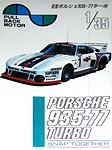
| Snap together kit with pull-back motor. Decals for #1
|
| 1/38
| Century
|
| 
| Decals for #1, yellow front spoiler. Separate doors.
|
|
| Kawai
| KT-100
| 
| Yellow plastic. Wind-up motor.
|
| 1/39
| Nitto
| 801
| 
| Snap-together model with a wind-up mechanism. Decals for Martini #1.
|
|
|
|
| 
| Most likely another issue of the above kit
|
| 1/43
| Entex
| 9101P
| 
| Snap kit. Box art is largely identical to the 1/38 Century/Kawai kit, suggesting one of them is listed with the wrong scale.
|
|
|
|
| 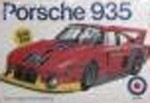
| Likely a reboxing with different decals
|
1977 Porsche 935-77 (customer)
During the winter of 1976/1977 thirteen customers cars were built, for the 1977 season, and they are therefore referred to as 935-77 customer cars. They are virtual copies of the 935-76 with the fourth body style: circular headlight covers and square rear fenders. Engines were single-turbo like the 935-76. The rear wing was single-element like the 935-76 (sometimes later replaced by a two-element wing). The louvres in the front fenders were also retained. The only external differences are turning indicators inside the headlight 'tubes' and 'running boards' between the front and rear fenders (if fitted). Several versions of the running boards were used, but it is unclear what the factory originally included with the car. The first works 935-76 (that had been used in two races only) was sold to Vasek Polak (USA) and was also run as a 'customer' car.
|
| 1/24
| Studio 27
| TK2474
| 
| Extensive transkit, with a complete resin body, metal wheels and rubber tyres, a few metal engine parts, three photo-etch sheets, one decal sheet. Decals for white #51 with Vaillant markings, Zolder 1977. Recommended base kit: Tamiya 934.
|
|
|
| TK2479
| 
| Same as TK2474, unclear why Studio 27 renumbered several kits.
|
|
|
| TK2475
| 
| Extensive transkit, with a complete resin body, metal wheels and rubber tyres, a few metal engine parts, three photo-etch sheets, one decal sheet. Decals for orange #52 with Jagermeister markings, Zolder 1977. Recommended base kit: Tamiya 934.
|
|
|
| TK2480
| 
| Same as TK2480, unclear why Studio 27 renumbered several kits.
|
|
| Custom FX
|
| 
| Listed as a 'Porsche 935-77 Jagermeister Le Mans IMSA' kit on Ebay, maybe it's a 1978 customer car body instead? Possibly a recast of the Scale Design body. Recommended base kit: Tamiya 934.
|
1977 Porsche 935 Baby
The single 'Baby' had a 1.4 litre engine to compete in the under 2 litre class of the DRM during the 1977 season, where BMW and Ford had an interesting battle. Porsche wanted to show it could also be competitive in this class, which received more media attention in Germany. Entered in two races only: Norisring (DNF, cockpit heat) and Hockenheim (1st) as #40, then retired to museum with its goal achieved. Also referred to as '935 B2' and '935 TT'. The QV500 Porsche pages list this car as the converted third 935-77 (935/77-005) and racing in the 1978 season, which I doubt.
The Baby had 935-77 style bodywork, with the front radiator opening blanked off, and likely the rear fenders were made 128 mm narrower in total. The engine oil and gearbox oil coolers were moved from the nose to the rear fenders. Air for the air-air intercooler entered behind the rear side windows. Left side exhaust instead of rear exhaust, with an ingenious exhaust-blown intercooler system. Car weight was decreased from 970 to 725 kg, partly achieved by replacing the front and rear structures with aluminium frames. Engine had a single turbo, 370 hp. Narrower rear wheels, 14" maximum in the regulations, therefore the rear fenders were made less wide. In the first race (Norisring) 16" instead of 19" diameter rear wheels were used since the gearing was completely wrong.
|
| Overall length
| 4680 mm
| Front track
| 1502 mm
| Front wheels
| 11 x 16"
|
| Overall width
| 1870 mm
| Rear track
| 1457 mm
| Rear wheels
| 13.5 x 16" and 13.5 x 19"
|
| Height
| 1265 mm
| Wheel base
| 2271 mm
| Weight w/o fuel
| 720 kg
|
|
| 1/24
| Esci-Ertl
| 3069
| 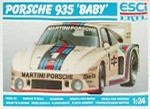
| A rather inaccurate kit of the Baby. Former Nitto 935-77 mold, Esci bought several Nitto molds after the company went under in 1985. Motorization options appear to have been removed. It lacks several 'Baby' details, like the reduced track of the rear wheels, reduced rear fender width, side exhaust, the front radiator opening isn't blanked off, and likely many more details are wrong. Decals for #1, not sure whether this number was used by the real car. Ken Mouton (via Wayback Machine) built it with several modifications. When Esci was taken over by Ertl, the kit was reissued as an AMT-Ertl 935-77.
|
|
| Italeri
| 3639
| 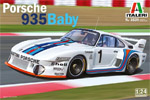
| 2020 reissue of the above model, with the same shortcomings for a Baby. 68 parts. Excellent Cartograf decals for Martini #40 (Norisring and Hockenheim 1977), including the Martini logos that are not shown on the box art. 'RL930' built it with several modifications. Also included are decals for non-Baby 935-77 that ran at Brands Hatch 1977, with #1 (it also ran in other races with this number, but the decal instructions say it's Brands Hatch). Similarly, an extra '5' decal allows #50, another regular 935-77 that ran in the '200 Meilen von Nürnberg'. '41' can also be made, and would represent the 1977 Le Mans entry. However it had double headlights, that the model doesn't have. With these extra decal options Italeri implicetely confirms the model actually is a regular 1977 works version, not the Baby. 'Davi' shows his model on Britmodeller, and makes several comments.
|
1976 Porsche 935-K2
|
|
The 935 K2 was a Kremer modified 935-77 customer car, with bodywork by Design Plastic (DP). It has 1976 customer car specifics with K3-like vertical strips on the fenders. The 70 kg bodywork was designed for quick release, so the car could be disassembled in 5 minutes. Pneumatic jacks installed. Kremer built one 935-K2 on bare chassis # 007 00016. It was raced in the 1977 season in the green Vaillant scheme. In 1978 it had three other liveries, see Photos of Chassis 007 00016. It was destroyed on 18 Juni 1978 at Mainz-Finthen, driven by Louis Krages aka John Winter. A standard customer 935-77 delivered to Kremer was fitted halfway the 1977 season with K2 bodywork too, see Photos of Chassis 930 770 0903.
Data listed below by Kremer.
|
| Overall length
| ? mm
| Front track
| ? mm
| Front wheels
| 11J x 16" with 10.0/23.5_16 Goodyear tires
|
| Overall width
| ? mm
| Rear track
| ? mm
| Rear wheels
| 14.75J x 19" with 14.0/27.5_19 Goodyear tires
|
| Height
| ? mm
| Wheel base
| ? mm
| Weight w/o fuel
| 970 kg
|
|
| 1/20
| Tamiya
| GC2008
| 
| Issued in 1979. Decals for both green (#4 and #51) and white (#70) Vaillant cars, but no complete decal set for the white car. Can be built with motorization or with a detailed engine. See build report by Duncan1098 on Automotive Forums.
|
|
|
| 20008
| 
| Reissue, contents identical.
|
|
|
| 20071
| 
| 2023 reissue, with Cartograf decals. Motorization deleted.
|
| 1/24
| Beemax
| B24015
| 
| Released in July 2018, decals for white '70' Vaillant car. A photo-etch set (E24015) is also available. Rich Chernosky shows his two models on the MCM forum.
|
|
|
| B24025
| 
| Expected May 2022, decals for #45 car with Ricoh sponsoring, 1978 Le Mans 24 Hours. Review on IPMS-USA by Chris Smith, with a complementary review of the Detail Up Parts
|
1978 Porsche 935-78 (works)
The factory redesigned the 935 radically, using a loophole in the FIA rulebook, by lowering the complete car some 10 centimeters. Also called Moby Dick. The car initially had full width doors with NACA ducts and a full width and low-set rear wing, but these had to be redesigned before the first race (some models represent this pre-season design). Only one example was built, no customer cars were built in 1978, and it was raced only four times, all in 1978. Models with markings other than Martini are actually Joest-built replicas, usually designated 935-81, but still listed here.
|
| Overall length
| 4890 mm
| Front track
| 1630 mm
| Front wheels
| 11 x 16"
|
| Overall width
| 1990 mm
| Rear track
| 1575 mm
| Rear wheels
| 15 x 19"
|
| Height
| 1200 mm
| Wheel base
| 2273 mm
| Weight w/o fuel
| 1025 kg
|
|
| 1/12
| Bandai
| 35401
| 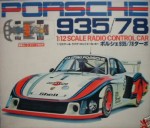
| RC model, with a body molded in white plastic, and separate window pieces. Full decal sheet with Martini markings.
|
|
| Nichimo
|
| 
| RC model, represents the pre-season car. Vacuum-formed Lexan body (to be painted from the inside), and sticker decals. The rear wing is an injected part, and about the only detailing part.
|
|
| Imai
| B671
| 
| RC model, vacuum-formed body. Judging from a photo of a built-up car, the body doesn't look right. The tail looks too short, cockpit section too wide, nose looks too high, and the windshield is too vertical.
|
|
| Carrera Structo
|
| 
| RC model, plastic body that looks accurate. It fits the Tamiya 935 chassis, creating very interesting kit-bashing possibilities. Decals/stickers for Liqui Moly #66 (Rolf Stommelen), a Joest 935-81 replica was raced in this livery.
|
|
|
|
| 
| Another boxing
|
|
| Fujimi
|
| 
| RC model. Vacuum-formed body
|
|
| Value Motorwave
|
| 
| Based only on the box-art similarities, this could be a reissue of the Fujimi RC model. Body looks injection molded. Decals or stickers for Martini #43.
|
|
| Otaki
|
| 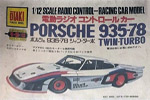
| RC model. Body represents the pre-season style with full width doors with NACA ducts and low-set wing. Listed in 1979 catalog.
|
|
| ABC Brianza
| ABCK1208
| 
| Resin model. Also available as a built-up model, coded ABCM1208
|
|
| Classic Models Museum
|
| 
| Resin model, reportedly a run of 20 models only. Full cockpit detail, but no engine. Includes decals and photoetched parts.
|
|
| Model Factory Hiro
| K740
| 
| Resin and white metal model. Full cockpit and engine detail. Decals for Martini #43. Build reports by Bruce Tanaka and Chris Smith on the MCM forum.
|
| 1/16
| Aoshima
| RC-02-4800
| 
| RC model, with a body molded in white plastic and an aluminium chassis. Body represents the pre-season style with full width doors with NACA ducts and low-set wing. Decals for #15 that never existed as far as I know.
|
|
| Revell
| H8201
| 
| Very likely a reissue of the Aoshima RC model, note box art similarities. Single-piece body molded in white plastic. Decals for #15
|
|
| Entex
|
| 
| RC model, race number 3, listed in 1979 catalog. Rear wing different compared to Revell/Aoshima model
|
| 1/24
| Tamiya
| SS-2410
| 
| Early Tamiya model, not current Tamiya quality. Interior compromised for motorisation, with the battery cover taking up too much space and reducing the roll cage size (which is incomplete anyway). Engine detail limited to what's molded in the chassis. Decals for #1 (Silverstone 1978) and #43 (Le Mans 1978). 'Richy78', 'Sennake' and '935k3' all built this model to a high standard. Bruce Scully built his a the red Momo car.
|
|
|
| 24010
| 
| Second version of the box art.
|
|
|
| 24318
| 
| 2010 reissue of 24010 with Cartograf decals. Revised instruction sheet, with different order and all motorization details left out.
|
|
| Crown
| 10
| 
| Reboxing of the Tamiya kit. Crown logo (red and blue squares with crowns) instead of fairly similar Tamiya logo. Motorized
|
|
|
| 9409
| 
| Another reboxing of the Tamiya kit. Crown logo is different, just one blue square with a crown. Motorized
|
|
| Ben Hobby
| T7
| 
| Ben was a brand that usually leased Tamiya molds. This model is confirmed as identical to the Tamiya kit. The only difference appears to be the decal sheet, which contains exactly the same items, but organised in a different way.
|
|
| Fujimi
| SM2
| 
| Possibly the first boxing of the Fujimi 935-78, most likely only for the Japanese market. Decals for #43 and #1/1S in Martini markings
|
|
|
| SM11
| 
| 'Super Mechanic' series. Assuming that the Tamiya 935-78 is closest to true 1/24 scale, then the Fujimi is too wide, front and rear, and the molding around the window trim is a little exaggerated. There is a significant difference in the slope of the nose (in side view), and widths and positions for the front openings are different. It was designed as a battery powered model. The chassis is molded with a battery box taking up most of the cockpit area. The insert supplied as an interior is severely shallow due to the battery box. It has only a single roll hoop. There is no engine detail except what is relief molded into the chassis plate. The kit is mostly useful as a source of body parts, wheels and tires. It is reported that the wheels and tires are off-scale, but I am not sure of this. Decals for #43 in Martini markings. See here for a built-up model.
|
|
|
| SM12
| 
| Alternative boxing, with a black car with Martini markings (#43).
|
|
|
| SM21
| 
| Special version with a metal chassis plate and a front mounted motor for better track performance.
|
|
| Testors
| 352
| 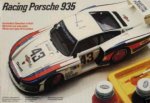
| Rebox of the Fujimi model, with Fujimi logos on the box and instruction sheet.
|
|
|
| Gunze Sangyo
| G114
| 
| Appears to be a Japanese boxing. This kit is much the same as the Fujimi but it is even wider. It seems 5 mm too short. The body has with some very nice details. There are significant differences in the slope of the nose (in side view) and widths and positions for the front openings are different. The interior is not as shallow but still not to scale and not useful for a detailed model. It is mostly useful for its wheels, tires and body parts. Martini decals for #43, fairly nice set.
|
|
|
| G123
| 
| The plastic is completely identical to the above. Pink and white color scheme for a Kremer car driven by Danny Ongais (#9). Kremer window banner. Not sure what it represents: it wasn't the factory original, and apparently neither one of two Joest replicas. Possibly it wasn't a 935-78 at all, making the kit rather inaccurate.
|
|
|
| G123
| 
| Slightly different boxing, with black instead of silver background and different (more recent?) Gunze-Sangyo logo.
|
|
|
| G138
| 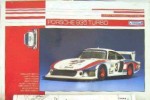
| Reportedly a 1985 issue, with Martini decals for car #43. A reissue with number G144 with decals for #3 is also reported.
|
|
| LS
| C523
| 
| Martini markings, strangely with #34 number whereas the real car raced with #43! Reportedly noticeably shorter tail than the Tamiya. Motorized, working head and taillights, racecourse guide bar. Race driver figure included.
|
|
|
| C523
| 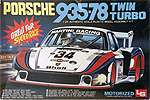
| International version of the above box, all Japanese text deleted.
|
|
|
| C535
| 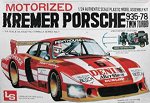
| Penthouse/Denim (aftershave) #6 markings, as reportedly used on a Joest 935-78 replica (no photographic confirmation yet). "Silhouette Formula Series #7". Body in red plastic.
|
|
|
|
| 
| 'Yoroshiku Mechadoc' issue. With standing figure. Decals for #34.
|
|
| LS-Scalecraft
| C523 ?
| 
| Scalecraft reboxing of the 'international' version of LS kit C523
|
|
|
| C523 ?
| 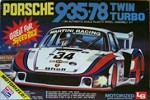
| Small variation of the above box
|
|
|
| C535 ?
| 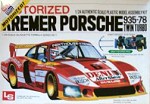
| Scalecraft reboxing with slightly modified box
|
|
| Nichimo
|
| 
| red livery with MOMO and Penthouse sponsorship, which identifies it as a Joest replica 935-81 as raced by Moretti. Motorized. Quality described as an unassembled motorized toy.
|
|
| Aoshima
| SR-09
| 
| Likely the original Japanese issue, with the box art full of Japanese texts
|
|
|
|
| 
| This box has German text, maybe there was an English version too? Simple model. Pre-season NACA-ducts in doors. No opening doors or lids. Electric motor (RE-26). 'Flattened' interior above the battery compartment, driver figure from mid-torso up. Extended wire front bumper for track racing. Decals for #S3. See here for a built-up model.
|
|
|
| 3G-60
| 
| Reissue or first issue. All Japanese text on the box and box sides. Decals for #S3.
|
|
|
|
| 
| Likely a reissue, 'White Special'. RE-280 electric motor, special front and side bumpers
|
|
|
|
| 
| Another boxing, a near 100% copy of the Tamiya original
|
|
| Tokyo Marui (aka Tilt)
| MT-78-W21
| 
| Typical motorized Japanese kit, with a nice body but little else.
|
|
|
| 07
| 
| Clear vacuum formed body, decals, metal chassis, for battery powered racing, with minimal details. The packaging consists of blister with cardboard backing (roughly A4 size, top quarter shown here as 'box-art'), instructions are printed on the back.
|
|
| USAirfix
| 8134
| 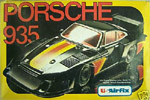
| A reissue of the Gunze Sangyo kit. Black plastic. Listed in 1981 USAirfix catalog as 06415-6, but probably not released as such. Reportedly also issued as 8040. It has the final aero layout of the doors, and some sort of bumper attached to the chassis/floorplate part
|
|
| Imai
|
| 
| Motorized, with a clear body
|
| 1/25
| Bandai
|
| 
| Huge NACA ducts on the sides and low rear wing. Most likely a model of the original Porsche car, but in the original trim, before the FIA demanded changes to the car. Reportedly tremendously inaccurate (windshield too vertical, squashed nose, tail dropping too steeply), and undersized, closer to 1/28 than 1/25 as printed on the box.
|
|
| Entex
| 9502
| 
| Reissue of the Bandai kit. Parts molded in black and white plastic.
|
| 1/28
| Nitto
| 665
| 
| A model of the pre-season car with full-width doors and a full width low-set wing. Motorized. It has 'flaming' Martini striping with small Martini logos, and has race number 21. Possibly identical to the so-called 1/25 Bandai kit?
|
|
|
| 14056
| 
| Later issue, 1985 catalog shows this catalog number. Slightly different box art
|
|
|
|
| 
| Different boxing. It has a FA-130 motor included.
|
|
| Hobby-Mac
| 14056
| 
| Box art is 99% identical to Nitto, catalog number is identical to the original Nitto issue. Motor included.
|
|
| Bluetank
| TK-8821
| 
| Taiwanese Nitto reissue. Bluetank issued many ex-Nitto kits in the early 1990's, after Nitto went under in 1985-1986. The box art is nearly completely (but not 100%) identical to the Nitto 14056 issue. Company logo is only shown on the box ends.
|
|
| Aoshima
|
| 
| Reported, but no details available.
|
|
| Tokyo Marui (aka Tilt)
|
| 
| Reported, but no details available.
|
|
| Sunny
|
| 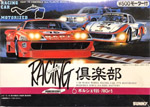
| Despite the box-art, the second car in the queue is contained in the box. From a partial view of the spures, it looks identical to the Nitto model. The decal set does not include Martini striping, instead a sheet with generic sponsor decals is included.
|
|
|
|
|
|
1978 Porsche 935-78 (customer)
Late 1977 fifteen customers cars were built for the 1978 season, and they are therefore referred to as 935-78 customer cars. These cars still used the 935-76 fourth style bodywork, with some small changes. The rear wing changed to two elements, the louvres in the front fenders were deleted, and the mesh-covered NACA inlets on the rear fenders were moved forward. Based on the study of one car (the restored Whittington Brothers car at the Spa Classics in 2010 and 2011) I think the rear fenders are more 'square', flatter and more vertical on the sides, with a smaller radius to the horizontal part, and the top sides do not angle down sideways, but are horizontal in that direction (not lengthwise). The radiators inside the rear fenders were rotated 90 degrees to lie flush with the door, the inlet itself was larger (extended down), and a curved panel in the fender guided the air. Running boards are almost standard fit, but again different versions are noted. The engine specs are identical to the 1977 works car with twin turbos, including moved bulkhead, that was used for larger intercoolers. Gelo used a works 935-77 bodied car during the 1979 season, and at least one USA car (Momo sponsoring) had the bodywork too; I don't know yet how this fits in. John Starkey has an overview of the 1977 and 1978 customer cars.
|
| 1/24
| Scale Designs
| SDT11
| 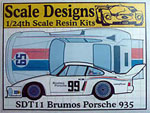
| Transkit for the 1978 Daytona #99 winner with Brumos markings, and the #59 car in similar markings. The #99 car is a 935-78 customer car with twin turbos. The 1978 Daytona #59 car is a 935-77 customer car with a single turbo, but Brumos also raced a 935-78 customer car (most likely twin turbo) that this kit also might represent. Reportedly a very accurate body with new wheels, interior pieces, sharp decals. The wheels and some interior bits are copies of the Esci/AMT 935-77. Tires are possibly too low profile, correct wheels though. No louvered vents in the front fender tops, that were present in at least some races. Tamiya Porsche GT-2 kit is used as the basis (rollcage and chassis).
|
1979 Porsche 935-79 (customer)
There was no factory team in 1979, but a last batch of seven customer cars was built late 1978 for the 1979 season. They are therefore referred to as 935-79 customer cars. They were generally identical to the 935-78 customer cars, but had a single turbo 3.1L engine (specifically for IMSA rules) and an inverted gearbox like the works 935-78. Front fender louvres are seen on a few cars.
|
| 1/24
| Scale Designs
| SDT7
| 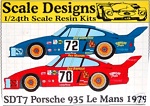
| Transkit for the 1979 Le Mans Hawaiian Tropic #70 and #72. Car #70 is confirmed as a 935-79 customer car. Car #72 was a 935-77 customer car, but had both single and twin turbo engines during its life.
|
|
|
| SDT12
| 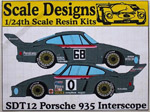
| Transkit for the 1979 Daytona #0 winner with Interscope markings, and the similarly marked #68 that participated in the 1979 Le Mans race. Both cars are confirmed as 935-79 customer cars. Kit includes full resin body, resin wheels with rubber tires, seat, dashboard, steering wheel, photo-etched sheet, vacformed windows and an UMi-designed decal sheet.
|
|
| Classic Racing Resins (formerly HobbiTime)
|
| 
| Transkit for the Beemax 935 K2 to build the Dick Barbour 935-79. Consists of resin front bumper, rear fenders and round grill holder, vacformed headlight covers. The kit's rear wing needs modifications too. Details here.
|
|
|
|
| 
| Transkit for the Beemax 935 K2 to build the Interscope 935-79. Consists of resin front bumper, rear fenders, external headlights as used at the Daytona with clear light lenses for the hood headlights, vacformed headlight covers. The kit's rear wing needs modifications too. Build report by Calvin Sallee. Details here.
|
|
| Beemax
| 24036
| 
| Announced for 2019, then 2022, the 2025. Decals for the 1979 Le Mans Hawaiian Tropic #70 car
|
1979/1980 Kremer Porsche 935-K3
The Kremer K3 was based on the 935-79, with some 100 changes, giving a 1% better performance according to Manfred Kremer. Three main changes are revised aerodynamics (clearly visible), a switch to an air-air intercooler and a stiffer car structure by extending the aluminium roll cage to the front and rear suspension points. The (rear) firewall was moved forward considerably to a position just behind the roll bar. This created the room required for the large air-air intercooler. 3.0 or 3.2 liter twin turbo engine. It used the same wheels and tyres as the factory 935-78.
There are two K3 body styles. First style (1979) had wing supports with a strong curve in side view, and the rear fender line dipped considerably behind the wheel. The second body style (1980) had wing supports that were almost straight in side view, and the rear half of the rear fender is almost horizontal. Sometimes identified as 935-K3/79 and 935-K3/80. The inlets in the rear fender also changed: the original car had intakes like the 935-76, then the front side of the fender became more square with a small inlet at the top, and on the left side only a small square inlet at the bottom.
|
| 1/8
| Mezzo Mix Models
|
| 
| 3D printed body, made on order body. Details under the front hood and in the cockpit area, but no engine.
|
| 1/12
| Modelpoint
|
| 
| Vacform conversion set from Germany.
|
|
| Mezzo Mix Models
|
| 
| Resin body with tires. First casting made in February 2019. Production ended 2021.
|
|
|
|
| 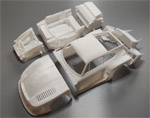
| 3D printed body plus chassis and additional parts. In preparation, first prints made in September 2021.
|
| 1/24
| Modelpoint
|
| 
| Vacform conversion set from Germany. Also reported as 1/20 scale. Build report in Scale Models November 1982 issue.
|
|
| Black Box
| -
| 
| Resin model with full interior but no engine. High-quality body casting. Includes photo-etched details, soft resin tires, metal axles and decals. 1979 Le Mans version with #41 Numero Reserve markings. Reportedly the dimensions are wrong: nose is too high with headlight problems, the rear fenders were not high enough at the trailing edge. Also reported as fixable errors. Motor Racing Models (formerly Motor Racing Replica News) did a one-page build review in issue 38.
|
|
| LMP (Little Garage Modelcar Production)
| 08
| 
| Resin curbside model from Japan. Reportedly nicely detailed resin and white metal parts and many photoetch parts, simple resin chassis. 1980 Le Mans Kremer #42, Italya pink and white liveried car. Expensive. Comments on its accuracy are that the nose section is not correctly done. The main problem is that the nose, measured from the splitter to the forward edge of the wheel opening, is some 6 to 8 mm too short. This makes the nose looking too blunt because the fenders drop too steeply, and also messes up the headlight area, because there is not enough room for a correctly sized headlight cover. Also, the side skirts are straight between the front and rear fenders on nearly all (or all?) K3's, whereas the model has curved sides.
|
|
| Scale Coachworks
| SCW-CK01
| 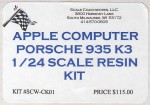
| Resin curbside model of the 1979 K3 version. It is identical to the LMP/Little Garage kit with a few amendments, some white metal parts converted to resin plus new decals. Decals for Apple Computers #71. Picture shown is not true box art, but the label on the box.
|
|
|
| SCW-CK03
| 
| Like SCWCK01, but with decals for Sachs #6 and #70.
|
|
|
| SCW-CK04
| 
| Like SCWCK01, but with decals for Jagermeister #2.
|
|
|
| SCW-CK05
| 
| Like SCWCK01, but with decals for Coke #5.
|
|
| Renaissance
| 24-11
| 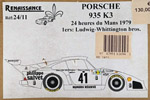
| Issued March 2011. Resin model with full interior but half-relief engine, lots of photo-etched details (kit contents). 1979 Le Mans winner version with #41 Numero Reserve markings. The interior does not look correct to me: the rear (engine) bulkhead is far more forward on the real car. Described a the best K3 so far.
|
|
| DiTech Produktion
| B 24-045
| 
| Slotcar body that could also serve as the basis of a static model. 1979 version with extra headlights fitted on the upper nose. One body resin part with a separate wing insert. Pretty rough castings, DiTech usually shows sanded and primed versions. Paper sheet with printed interior parts. Flat transparent sheet with pre-printed windows.
|
|
| Custom FX
|
| 
| Issued early 2012. Listed as an all resin remake of the Scale Coachworks kit. Single-piece body (no opening parts), chassis, some twenty detail parts, vacuum formed windows and lights. Wheels are included, but no tires - Tamiya Porsche 935-78 or Zakspeed Capri kits are recommended as donors. Two decal sheets for #9 and #71 Apple cars (IMSA and Le Mans respectively). The kit was reported to be updated, with body modifications and aluminium instead of resin wheels.
|
|
|
|
| 
| Issued summer 2013. Most likely identical parts as in the first issue, decals for #2 Jagermeister in the 1980 DRM championship. See here for 'lovegt40's model on Automotive Forums.
|
|
| Mysterious
|
| 
| Decals for #71 Apple Computers, 24 Hrs Le Mans 1980. Issued early 2013. Kit style described as 'relatively simple resin & metal kits, extremely similar in style to MG Models'.
|
|
|
|
| 
| Decals for #9 Apple Computers, 12 Hrs Sebring 1980
|
|
|
|
| 
| Decals for #2 Jagermeister, DRM 1980
|
|
|
|
| 
| Decals for #5 Coca Cola, 12 Hrs Sebring 1981
|
|
|
|
| 
| Decals for #5 Coca Cola, 24 Hrs Daytona 1981
|
|
|
|
| 
| Decals for #70 Sachs, 24 Hrs Le Mans 1980
|
|
|
|
| 
| Decals for #6 Sachs, 12 Hrs Sebring 1980
|
|
|
|
| 
| Decals for #6 Sachs, Nurburgring 1980
|
|
| Ortmann
|
| 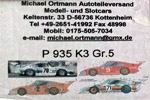
| Slot car body from 'Michael Ortmann Autoteileversand Modell- und Slotcars'. Resin body with insert for the rear side and a wing. Vacform windows. No decals.
|
|
| Platz / NuNu
| 24006
| 
| Issued in December 2019. It shares the chassis and some other parts with the Beemax 935 K2, but has a new body and many other parts. The front fenders are integral parts of the body, but the rear fenders are two parts on either side. The interior features the firewall moved forward to a position just behind the seat. Half-relief engine and gearbox, lower side only. Decals for the Numero Reserve #41 winner of the Le Mans 1979 24 hours. Review on the IPMS USA website.
My first impressions are that body has serious shape problems, it looks 'weird', just not like a 935. Compared to the Tamiya 935-76, the greenhouse and front cover are approximately the same. But the skirts are too tall, the headlight area similarly, and the rear fender sides sit too low. By taking out a 'wedge' from nose to rear fender, the front half of the body can be corrected, but you'll be cutting through the headlights. At the rear, the fender sides must me raised by 2 mm, followed by modifications to the top side of the rear fenders. The front wheel opening is too small too.
|
|
|
| 24029
| 
| Issued September 2021. Decals for the pink & white Gozzy sponsored #42 car, Le Mans 1980. The kit contains additional parts compared to 24006, to build the 1980 version of the K3. The 1979 parts are still included.
|
|
| Classic Racing Resins (formerly HobbiTime)
|
| 
| Rear fenders for the Nunu-Platz Porsche Kremer 935 K3 to create the version that ran in the 1980 24 Hours of Le-Mans. Two resin parts. Details here.
|
|
|
|
| 
| Rear fenders for the Nunu-Platz Porsche Kremer 935 K3 to create the Itariya Gozzy version that ran in the 1980 24 Hours of Le-Mans. Two resin parts. Details here.
|
|
|
|
| 
| Rear fenders for the Nunu-Platz Porsche Kremer 935 K3 to create the Apple Computers version that ran in the 1980 24 Hours of Le-Mans. Two resin parts. Details here.
|
|
|
|
| 
| Rear fenders for the Nunu-Platz Porsche Kremer 935 K3 to create the Jagermeister version that ran early in the 1981 DRM season. Two resin parts. Details here.
|
|
|
|
| 
| Rear fenders for the Nunu-Platz Porsche Kremer 935 K3 to create the Bob Akin version that ran in the 1981 24 Hours of Le-Mans. Two resin parts. Details here.
|
|
|
|
| 
| Rear fenders for the Nunu-Platz Porsche Kremer 935 K3 to create the Cooke Woods / Style Auto version that ran in the 1981 Daytona 24 Hr. Two resin parts. Details here.
|
|
|
|
| 
| Transkit version 1, for the Nunu-Platz Porsche Kremer 935 K3, to create the 1980 #2 Jagermeister car during the first half of the season. Includes new fenders, wing struts, wing endplates, engine cover and rear plate, bumpers. Details here.
|
|
|
|
| 
| Transkit version 2, for the Nunu-Platz Porsche Kremer 935 K3, to create the 1980 #2 Jagermeister car during the second half of the season. Includes new fenders, wing struts, wing endplates, engine cover and rear plate, bumpers. Details here.
|
|
| SK Decals
| TK010
| 
| Rear fenders for the Nunu-Platz Porsche Kremer 935 K3 to create the 1980 version.
|
|
| Model Car Collection
| MC124-02
| 
| Decals for 1980 Jagermeister #2 car. Resin kit with metal rollcage parts and rubber tires, vacform windows, extensive photo-etch sheet and seat belt ribbon. The body and chassis look identical to the LMP kit, that was also used for the Scale Coachworks kit.
|
|
|
|
| 
| Decals for 1980 Apple #71 car, Le Mans.
|
| 1/32
| Racer
| RCR22
| 
| Slot car model with a nicely detailed resin body, 1979 style, with #41 Kremer markings (1979 Le Mans winner). The Italian manufacturer also listed as 'Racer Slot Cars'. RCR22 is ready to run, RCR22P is a painted kit, RCR22K is an unpainted kit.
|
1980 Porsche 935-80
The factory had stopped producing customer cars, since they had no capacity, and because the Kremer K3 was superior. The factory did sell the latest parts such as the air-air intercooler, mechanical parts and body parts. A complete 935 to the latest specs could be bought in parts, and assembled by the customer. Joest and Loos tried various things to bring their cars up to speed with the Kremer K3, and therefore the situation with the '935-80' version is complex - there is no standard 935-80.
Some collected comments on the 935-80: "Similar bodied cars were entered in the 1980 DRM by Joest/Liqui Moly for Stommelen & Gelo/Kraus Hifi for Bob Wollek. The later also ran at Le Mans. Joest won 1980 24 Hours of Daytona with a 935 Baby. Such cars were entered at Le Mans in '81 (Joest/de Narvaez) & '82 (Joest/Vegla). The same (?) car won the '84 12 Hours of Sebring." and "The cars that resemble the "Baby" were the official Porsche 935/77 2.8 liter (over 2 liter) Group 5 versions. Many teams ran those. The factory even provided blueprints to Joest and they built authorized copies which Joest themselves ran before selling them to privateers like Moretti."
|
| 1/24
| Aardvark Models
|
| 
| Resin body of the 1980 Daytona 24H winner, built by Joest and sometimes referred to as a 935J. It started life as a 1978 customer car. In 1980 it resembled the factory 935-77 body, but with changes to the inlets at the front of the rear fenders, and additional big NACA ducts in the wing supports. The kit contains the bodyshell, rear wing, frame for the original 911 rear window which sits below the kit rear window, and the auxillary lights mounted on the hood.
|
1981 Joest Porsche 935-81
Joest built two replicas of the 935-78. Both were right-hand drive as opposed to the factory car that had left-hand drive. These raced in Europe a couple of times in Momo (red, yellow trim) and Lui (white, black lettering). They then went to the USA, to the private teams of Fitzpatrick (J David) and Moretti (Momo/Penthouse) and raced in the 1981-83 time frame. Possibly '935-81' is not an official designation.
|
| 1/24
| Renaissance
| TK24-300
| 
| Transkit consisting of two resin door inserts, and sometimes four resin wheel covers and two resin parts that go inside the long tail. An excellent build report by "Grasset2005" can be found on the Automotive Forums site
|
|
| Custom-FX
|
| 
| Resin body only, for the John Fitzpatrick 1982 Le Mans. Listed on Ebay as a 935-82, but references use the 935-81 or JR-2 designation. The Tamiya 935-78 is recommended as the base car, decals available from Renaissance.
|
|
|
|
| 
| Resin body only, for the Moretti Momo IMSA car of the early 80's. Listed on Ebay as a 935-82, but references use the 935-81 or JR-2 designation. Body has as full length doors (no aerodynamic covers) and proper fender vents. The Tamiya 935-78 is recommended as the base car, decals available from Strada Sports.
|
|
| Classic Racing Resins (formerly HobbiTime)
|
| 
| Transkit for the Tamiya 935-78 to build the 1981 IMSA Momo 935. Consists of resin doors, rear wing assembly plus wheels and tires. Details here.
|
1981 Kremer Porsche 935-K4
Kremer built two K4's that were loosely based on the 935-78. The Barth/Dobronz book reports that the cabin was tilted backwards slightly, to improve the rear axle position. Data from 'Gruppe 5 Die Silhouetteformel 1976-1981'.
|
| Overall length
| 4875 mm
| Front track
| -
| Front wheels
| 11 x 16"
|
| Overall width
| 1996 mm
| Rear track
| -
| Rear wheels
| 14.75 x 19"
|
| Height
| 1180 mm
| Wheel base
| 2250 mm
| Weight w/o fuel
| 1025 kg
|
|
| 1/24
| DiTech Produktion (DP)
| B 24-032
| 
| Slotcar body that could also serve as the basis of a static model. One body part with a separate wing insert. Lip ahead of bonnet slopes down instead of running horizontal. Pretty rough castings, DiTech usually shows sanded and primed versions. Paper sheet with printed interior parts. Flat transparent sheet with pre-printed windows.
|
1983 Andial Porsche 935-L
Andial designed and built a single 935-L, that was raced in the 1982, 1983, 1984 and 1985 IMSA seasons. Again the design was based on the 935-78. It had filled-in doors with a large NACA-inlet on the top side, a long tail and a narrow rear wing. Andial built the chassis and suspension, A.I.R. built the body.
|
| Overall length
| ?
| Front track
| -
| Front wheels
| ?
|
| Overall width
| ?
| Rear track
| -
| Rear wheels
| ?
|
| Height
| ?
| Wheel base
| ?
| Weight w/o fuel
| ?
|
|
| 1/24
| Custom FX
|
| 
| Resin kit with single-piece body, chassis, interior with roll cage, engine detail, vacuum formed front and rear windows and rubber tyres. Photo etched details. Silkscreen printed decals of the 1983 Daytona winner, Henn's T-Bird / Swap Shop #6.
|
198x US Porsche 935s
A number of moderately to highly modified cars were built in the USA after Porsche stopped production. Apart from the 935-L listed above, no models exist of these replicas, as far as I know.
|
I will definitely not try to list all 934/935 pages, but here are some with good information on the factory and the customer cars of various years.
